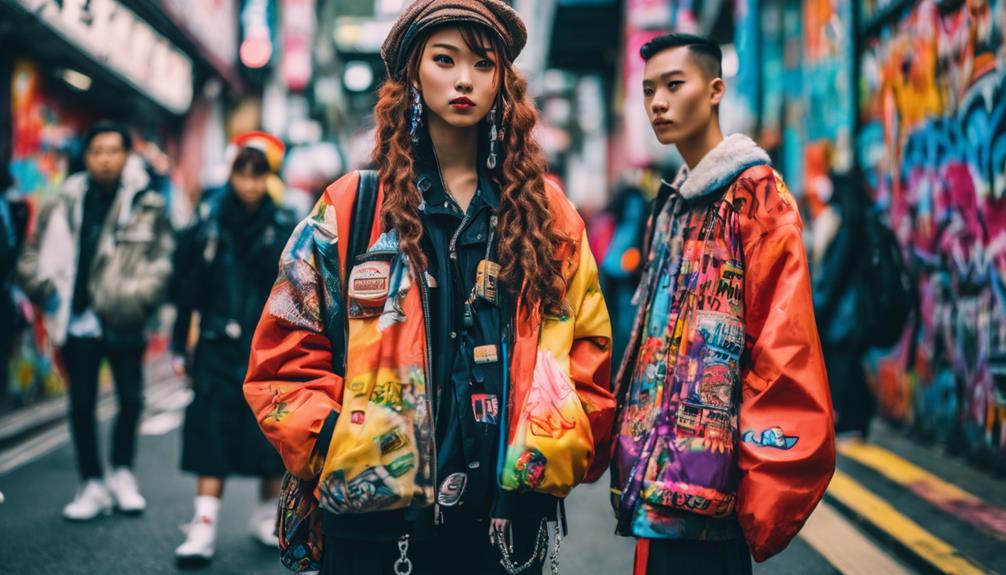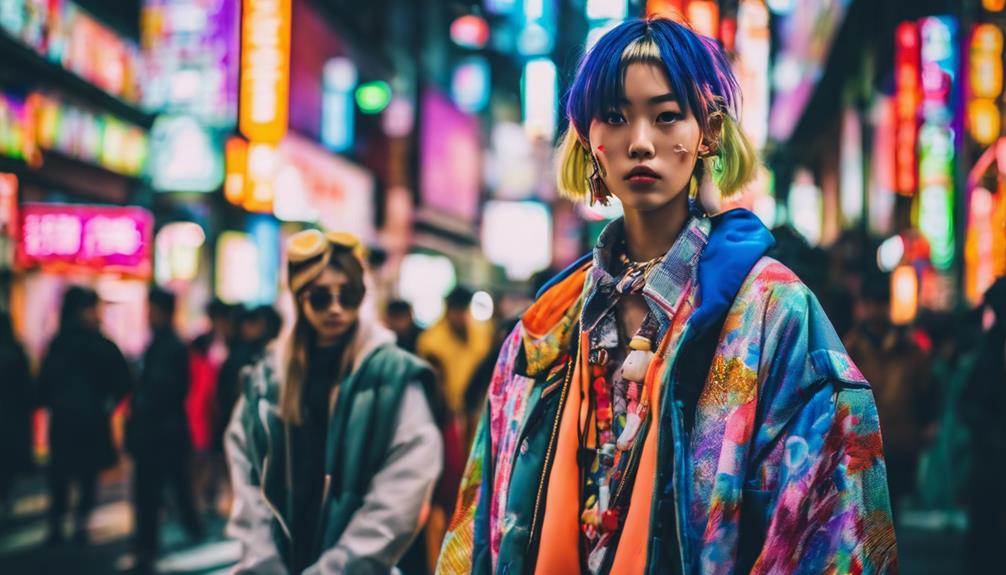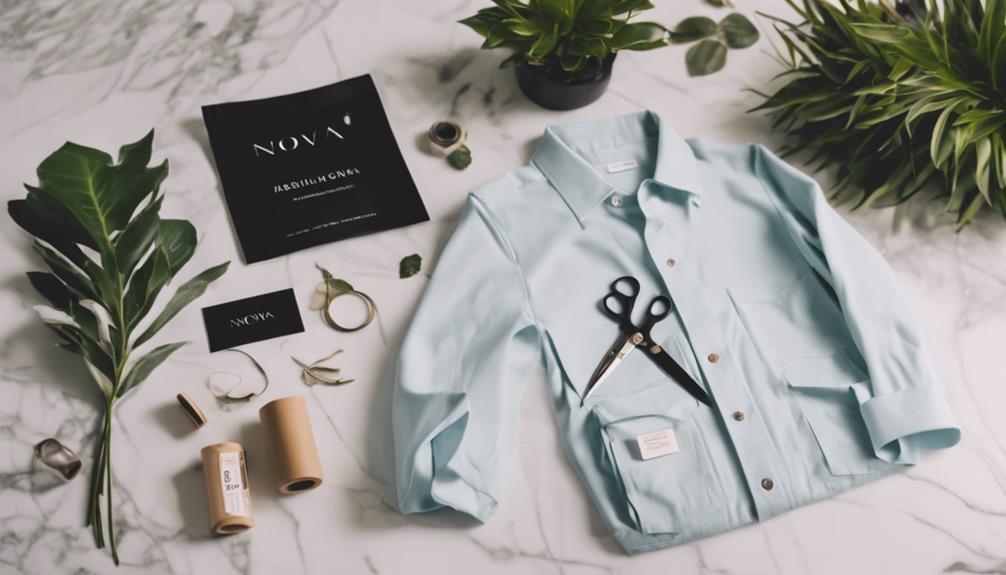Japanese street fashion is known for its bold expressions and innovative styles that defy traditional norms. Hailing from Harajuku, this trend seamlessly combines tradition with modern flair by featuring a mix of eclectic pieces, vibrant prints, and chunky accessories. Influenced by music and pop culture, individuals create unique looks that reflect their personal identity. Key players in this realm include iconic brands like A Bathing Ape and events such as Tokyo Fashion Week, where sustainability intersects with artistic design. Thrift shopping and upcycling opportunities abound, allowing you to partake in this trend while celebrating your individuality. Intrigued to delve deeper into the fascinating layers of this fashion phenomenon?
Key Takeaways
- Japanese street fashion emerged in Harajuku, blending traditional elements with modern aesthetics since the 1960s, reflecting youth identity and creativity.
- Key characteristics include eclectic layering, bold accessories, vibrant prints, and statement t-shirts that encourage personal expression.
- Modern interpretations are influenced by global trends, including streetwear and K-Pop, reshaping contemporary fashion with oversized silhouettes and unique brand identities.
- Sustainability is a growing trend, with upcycling vintage clothing techniques and thrift shopping fostering creativity and eco-friendliness in fashion choices.
Origin and historical background of the fashion trend/style
Japanese street fashion emerged from significant cultural shifts, especially in Harajuku during the 1960s and 70s, where youth began to express themselves through distinct styles.
This movement was heavily influenced by music trends and the rise of consumerism in the 1980s, shaping diverse fashion choices.
As you explore this evolution, you'll see how traditional elements mingled with modern aesthetics to reflect the identity of Japanese youth.
Cultural Shifts and Trends
Emerging in the 1960s and 70s, street fashion in Harajuku took off as youth culture sparked innovative styles and diverse subcultures. This vibrant scene was further fueled by Japan's economic boom in the 1980s, which allowed young people to explore their fashion choices more freely. As consumerism surged, you'd find an eclectic mix of styles blending traditional elements with contemporary flair.
In 1997, Shoichi Aoki's magazine *Fruits* played a pivotal role in documenting these evolving street fashion trends. It not only showcased unique outfits but also shaped the global perception of Japanese style. By the early 2000s, the influence of Japanese hip-hop began permeating mainstream fashion, considerably altering youth style preferences.
The cultural shifts didn't stop there; by 2019, Harajuku Fashion ranked 5th in Google Search of the Year, showcasing its global significance. Today, you can see how these historical influences continue to shape modern street fashion, proving that Harajuku remains a melting pot of creativity and bold expression.
Embrace this evolution and let it inspire your unique style!
Harajuku Subculture and Music
Harajuku subculture, fueled by the vibrant sounds of J-pop and rock, has greatly shaped the unique fashion styles that define this iconic Tokyo neighborhood. Emerging in the 1960s and 70s, Harajuku became a hub for youth embracing eclectic fashions. Music, particularly genres like J-pop and rock, greatly influenced these styles, inspiring trends such as Visual Kei and Oshare Kei.
The 1980s economic boom in Japan propelled consumerism, allowing for a diverse range of clothing choices that characterized Harajuku fashion. As the youth explored their identities, fashion became a canvas for self-expression, blending various influences seamlessly.
By the 1990s, magazines like *Fruits* helped globalize the Harajuku scene, showcasing the vibrant street styles that captured the world's attention. In the early 2000s, the rise of Japanese hip-hop merged urban aesthetics with traditional influences, further enriching Harajuku's fashion landscape.
You can see how music continues to inspire creativity in this neighborhood, as it remains a driving force in shaping the bold, avant-garde styles that define Harajuku today. Embrace the energy, and let the sounds of Harajuku guide your fashion choices!
Key Characteristics
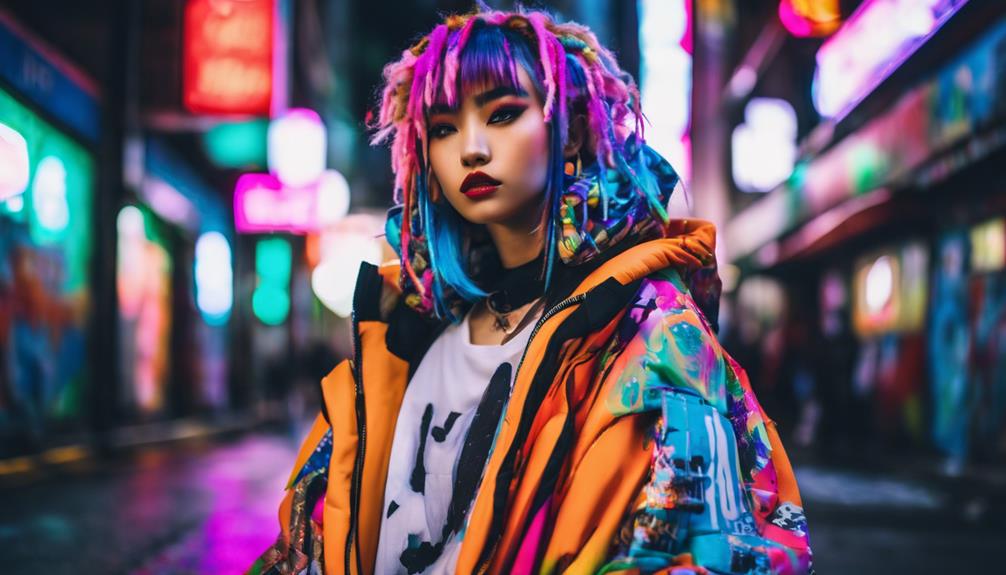
When you explore Japanese street fashion, you'll notice its eclectic layering and bold accessories that make each outfit unique.
Vibrant prints, textures, statement t-shirts, and platform shoes are key elements that truly stand out.
These characteristics reflect a rich blend of creativity and personal expression that defines this dynamic style.
Eclectic Layering and Bold Accessories
Eclectic layering defines Japanese street fashion, letting you mix textures, patterns, and styles to create a look that truly reflects your personal identity. This approach to street style encourages you to experiment with bright colors and bold patterns, showcasing your confidence and creativity. You can easily combine oversized sweaters with fitted skirts or layer a vintage shirt underneath a statement jacket, making each outfit uniquely yours.
Accessories are essential in enhancing your layered outfits. Consider adding oversized hats, chunky jewelry, or statement bags to elevate your look. These bold accessories not only complete your ensemble but also serve as conversation starters, drawing attention to your distinctive style.
Thrifting and vintage shopping are also popular, allowing you to incorporate sustainable fashion into your eclectic layers. By mixing and matching pieces from various subcultures, like punk and girly influences, you express your individuality through innovative layering techniques.
This dynamic interplay of styles reflects the vibrant spirit of Japanese street fashion and encourages you to embrace your creativity while curating a look that stands out in any crowd.
Vibrant Prints and Textures
Vibrant prints and rich textures are at the heart of Japanese street fashion, allowing you to express your individuality through eye-catching designs and unique fabric combinations. This style thrives on bold patterns and motifs, often reflecting cultural influences and personal creativity. By embracing vibrant prints, your outfits can showcase distinctive aesthetics that stand out in any crowd.
Layering techniques are essential in Japanese street fashion, enabling you to mix various textures and colors into visually striking ensembles. You can easily achieve a dynamic look by pairing different fabrics, creating depth and interest. Accessories also play a vital role, with oversized hats, statement jewelry, and colorful bags enhancing your outfit's overall appeal.
Don't forget to incorporate vintage and retro elements into your wardrobe. This approach not only allows you to create unique pairings but also connects you to past fashion trends. Bright colors dominate the landscape, whether you're rocking pastel shades in Girly Kei or the vivid palettes found in Decora Kei.
With vibrant prints and textures at your disposal, you can craft a style that's both bold and uniquely yours.
Statement T-Shirts and Platform Shoes
Statement t-shirts frequently showcase bold graphics and slogans that reflect your personality and current trends, making them a key element of Japanese street fashion.
In Tokyo's vibrant districts like Harajuku and Shibuya, these t-shirts serve as canvases for self-expression, often featuring unique artwork that aligns with social movements or personal beliefs. You'll find that many influential street fashion brands release limited-edition designs, collaborating with artists and designers to create pieces that appeal to fashion enthusiasts and collectors alike.
Pairing these statement t-shirts with platform shoes adds another layer to your outfit.
Platform shoes, ranging from chunky sneakers to high-heeled boots, elevate your height while injecting a distinctive edge into your look. This combination creates a visually striking appearance that embodies the playful and eclectic nature of Japanese street fashion.
Modern Interpretation
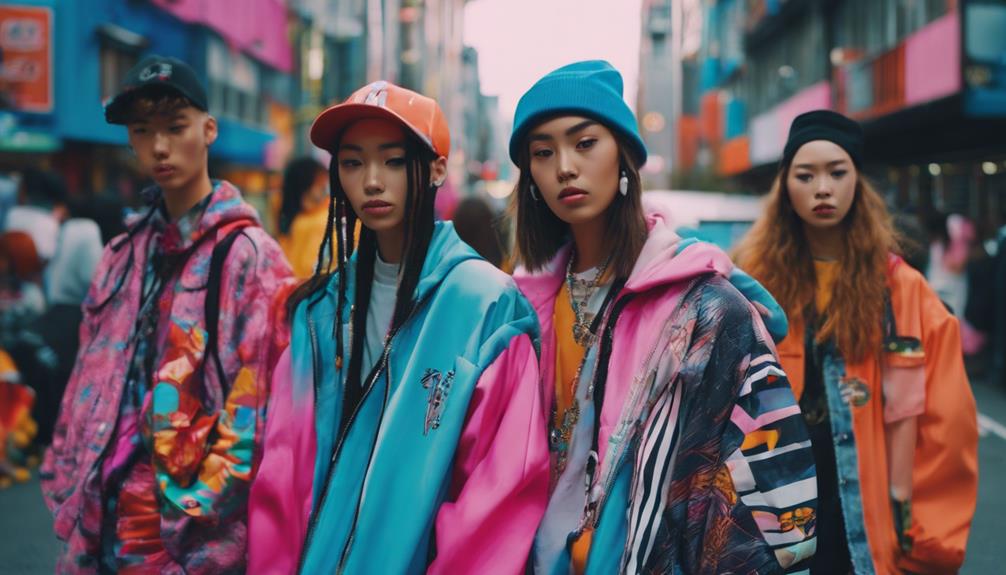
Modern Japanese street fashion isn't just about personal expression; it's heavily influenced by streetwear, icons, and the global impact of K-Pop stars.
As you explore these trends, you'll notice how brands and styles intersect, shaping the way youth present themselves.
Let's take a closer look at how these elements come together to create a vibrant fashion scene.
Streetwear Influences on Fashion
Japanese streetwear has reshaped fashion by blending urban aesthetics with high-end influences, making it a dynamic force in contemporary style.
Since the 1990s, this movement has evolved considerably, deeply rooted in hip-hop culture. You'll notice how styles emphasize bold graphics and oversized silhouettes, merging high and low fashion elements seamlessly.
When you stroll through Tokyo Street, you can see this unique fusion in action. Brands like A Bathing Ape (BAPE) showcase distinct designs that incorporate Japanese cultural motifs, making them stand out in the global streetwear scene.
Social media platforms like Instagram have amplified this, allowing influencers to share their Tokyo Street styles and spark worldwide interest in local trends.
Moreover, collaborations between streetwear brands and luxury labels, such as Comme des Garçons partnering with H&M, highlight the merging of street style with high fashion, attracting a broader audience.
As sustainability gains traction, many emerging designers focus on eco-friendly materials and thrifted fashion, reflecting a global shift towards responsible consumption.
This modern interpretation of streetwear not only influences how you dress but also shapes the entire fashion landscape.
Streetwear Icons and Labels
Streetwear icons and labels have become essential in defining contemporary fashion, showcasing a blend of traditional aesthetics and cutting-edge styles that resonate globally. Japanese brands like A Bathing Ape (BAPE) and Comme des Garçons lead the charge, influencing trends by merging cultural nuances with modern designs. Their collaborations, such as the notable partnership between Comme des Garçons and H&M, demonstrate how local labels adapt to international markets while retaining their unique essence.
At events like Tokyo Fashion Week, you'll notice a shift toward sustainability and individuality, with young designers stepping into the spotlight. This move away from fast fashion emphasizes the diverse influences inherent in Japanese streetwear. Styles draw inspiration from subcultures like Gyaru and Visual Kei, creating a rich tapestry of bold fashion statements that capture attention.
Social media, especially Instagram, plays a vital role in promoting these trends. Hashtags like #TokyoStreetFashion not only elevate visibility but also cultivate a global community enthusiastic to embrace Japanese streetwear. As you explore this vibrant scene, you'll see how these icons and labels continue to shape the future of fashion, resonating with style enthusiasts around the world.
Fashion-Forward K-Pop Stars
Blending bold colors and eclectic accessories, K-Pop stars are redefining fashion by incorporating elements from iconic styles like Lolita and Gyaru. You'll notice how these artists merge Japanese fashion influences with their unique flair, creating striking outfits that stand out on and offstage. This fusion of styles showcases vibrant layering techniques and an adventurous use of colors, reflecting the diverse aesthetics found in Japanese street fashion.
As you explore K-Pop visuals, you'll see how groups frequently collaborate with Japanese fashion brands, bringing subcultures like Harajuku to a wider audience. Social media, especially platforms like Instagram, serves as a canvas for these idols, allowing them to display their fashion choices and inspire fans globally.
This cultural exchange between K-Pop and Japanese street fashion is evident as performers draw from both traditional and contemporary styles, crafting their distinctive images. By embracing elements of punk, girly, and vintage aesthetics, K-Pop stars are setting new trends and elevating the impact of Japanese fashion on the global stage.
Styling Tips
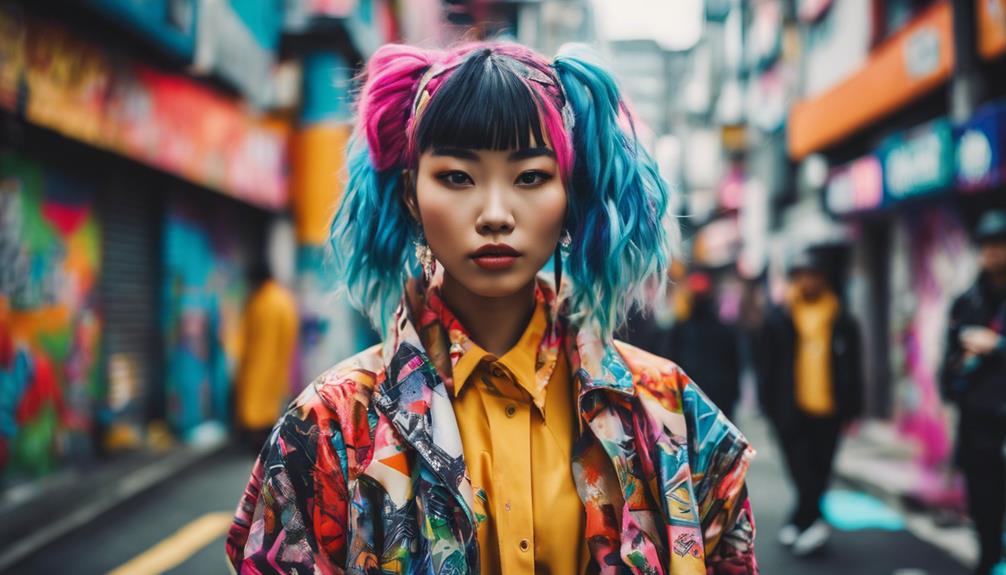
When it comes to Japanese street fashion, the right styling tips can elevate your look.
You'll want to focus on statement accessories and footwear that grab attention.
Additionally, experiment with layered outfits that blend vintage accents and unconventional patterns.
Statement Accessories and Footwear
Incorporating bold statement accessories and unique footwear can instantly elevate your outfit, showcasing your personal style and creativity in Japanese street fashion.
Start with oversized earrings or layered necklaces—they're essential in this style. These statement accessories not only draw attention but also reflect your individuality, allowing you to express your personality through fashion.
When it comes to footwear, opt for platform sneakers or colorful boots. These choices add height and a striking aesthetic, making your shoes a focal point of your look. Brands like A Bathing Ape (BAPE) and Onitsuka Tiger (ASICS) offer innovative designs that can enhance your outfit while staying on-trend.
Don't forget about bags! Unique and artistic bags, whether they're miniatures or elaborate designs, serve as fantastic conversation starters and enhance your overall flair.
Layering accessories—think multiple bracelets or rings—adds depth to your ensemble and allows for customization.
Layered Looks With Vintage Accents
Layered looks with vintage accents let you showcase your creativity and personality while embracing the charm of thrifted finds. This style is all about mixing textures and colors, allowing you to create eye-catching outfits that reflect the vibrant spirit of Japanese street fashion. People wear various vintage items, such as oversized jackets, patterned shirts, or unique skirts, to enhance their looks.
To achieve a stunning layered outfit, start with a solid base, like a simple t-shirt or fitted dress. Then, add vintage pieces, such as a colorful cardigan or a retro vest, to create depth. Don't shy away from bright colors and bold patterns—these elements are essential to standing out.
Accessories also play an important role in layered looks. Incorporate statement jewelry or a funky hat to add individual flair. You can even include traditional Japanese elements, like kimono-inspired pieces, to merge modern fashion trends with heritage influences.
Layering Unconventional Patterns
Mixing unconventional patterns can elevate your street style, allowing you to express your unique flair while embracing the vibrant essence of Japanese fashion. To master this art, start by layering bold prints like floral tops with plaid skirts or mixing polka dots with stripes. This playful approach is a hallmark of Harajuku fashion and invites creativity into your wardrobe.
Don't shy away from vintage pieces; they not only add character but align with sustainable fashion trends. For instance, an Issey Miyake pleated piece can serve as a stunning focal point. Pair it with geometric patterns or quirky prints to make a statement.
Accessories are essential in your layered looks. Think oversized scarves, statement belts, and eclectic jewelry that enhance your outfit's visual impact. They can seamlessly tie together disparate patterns, ensuring your ensemble feels cohesive rather than chaotic.
Lastly, remember that layering offers versatility. You can shift your look from casual to formal by adjusting the pieces you wear together. Embrace the unexpected, and let your imagination run wild as you create outfits that reflect your personal style!
Shopping Guide
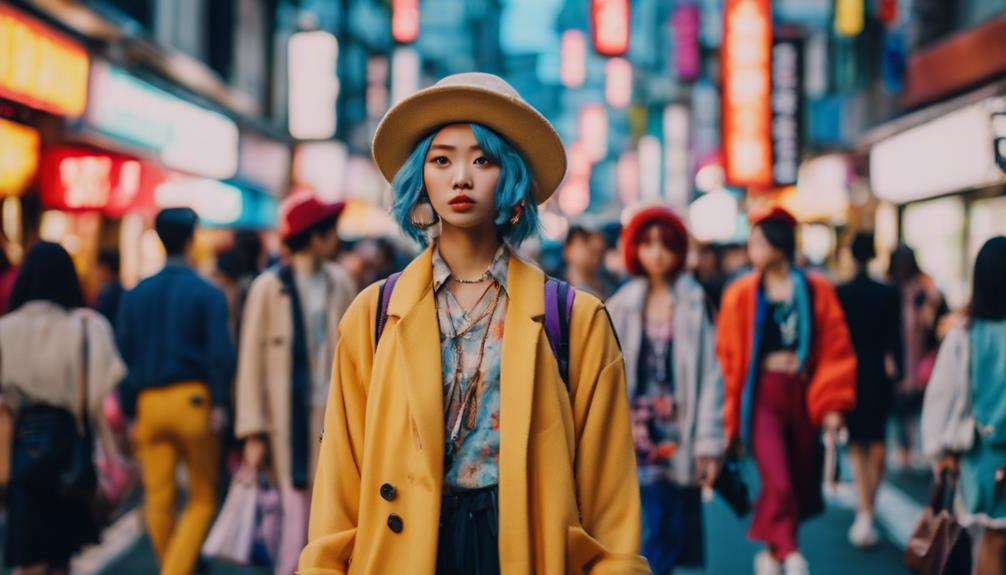
When you explore Tokyo's vibrant shopping districts like Harajuku, Shibuya, and Ginza, you'll discover a thrilling array of street fashion that caters to every style and subculture.
Start your journey at Laforet Harajuku or Shibuya 109, where trendy boutiques and unique fashion items abound. These locations are perfect for finding pieces that reflect both contemporary and traditional Japanese aesthetics.
Don't miss the chance to check out iconic brands like Yohji Yamamoto, known for his avant-garde designs that challenge conventional fashion norms. His pieces often blend artistry with wearability, making them a must-see.
In addition to established brands, you'll find countless independent shops and thrift stores that offer sustainable options for those hunting for one-of-a-kind treasures. Immerse yourself in the vintage scene and uncover gems that tell a story.
If you're short on time or prefer shopping from home, explore online platforms that feature a variety of Japanese street fashion brands. This way, you can access the latest styles, ensuring your wardrobe stays fresh and bold, no matter where you are.
Happy shopping!
Upcycling Vintage Clothing Techniques
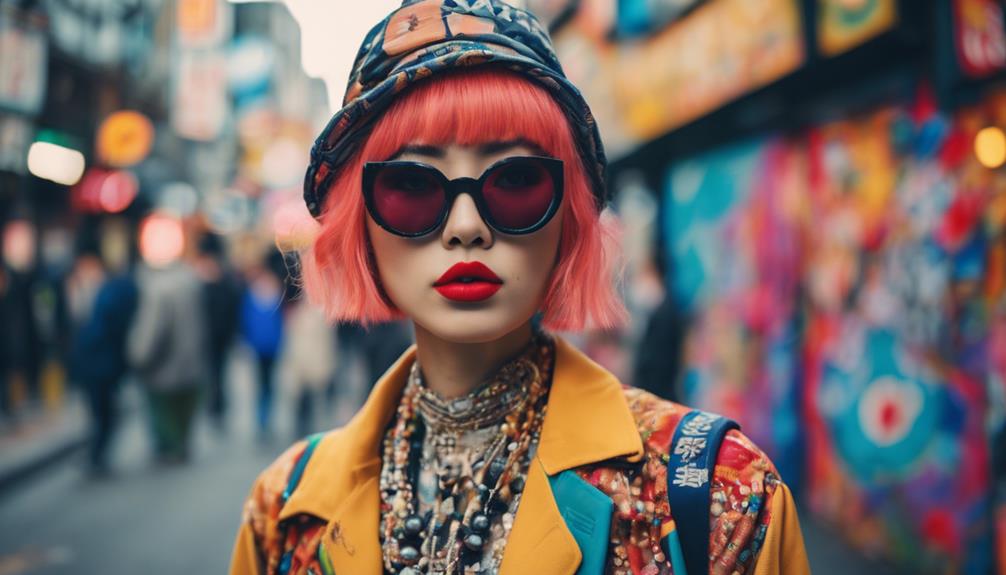
When you upcycle vintage clothing, you can repurpose old fabrics into stunning, one-of-a-kind pieces that showcase your creativity.
Techniques like sashiko stitching not only enhance the garment's aesthetic but also tell a story of craftsmanship.
Let's explore how these methods can transform your wardrobe and contribute to sustainable fashion.
Repurposing Old Fabrics
Repurposing old fabrics in Japanese street fashion not only fuels creativity but also champions sustainability, turning vintage clothing into fresh, one-of-a-kind pieces. By embracing upcycling techniques, you're tapping into a vibrant movement that focuses on eco-conscious fashion trends.
Many Japanese designers skillfully transform old garments, especially traditional textiles like kimonos, into contemporary streetwear, blending cultural heritage with modern aesthetics. Techniques like patchwork, dyeing, and embellishment allow you to express your unique style while minimizing waste.
This approach aligns perfectly with the growing appreciation for nostalgia among younger consumers, who flock to thrift shops and second-hand markets. As you explore these spaces, you'll discover countless opportunities to find hidden gems ready for transformation.
Moreover, events and communities dedicated to upcycling foster a spirit of creativity and skill-sharing. You'll find that these gatherings encourage individuality in fashion choices, allowing you to stand out while making sustainable choices.
Sashiko Stitching Techniques
Incorporating Sashiko stitching techniques into your upcycling projects not only enhances the durability of vintage clothing but also adds a unique artistic flair that honors traditional Japanese craftsmanship.
This technique, which originated during the Edo period, was primarily used to mend and reinforce worn-out garments, especially among the working class. By using a simple running stitch, you can create intricate patterns that transform your pieces while ensuring they're long-lasting.
When you practice Sashiko stitching, consider using contrasting thread colors to highlight your designs. The classic combination of white thread on indigo fabric beautifully reflects the technique's historical roots.
This method is gaining traction in the fashion industry as a sustainable practice, aligning with the increasing focus on upcycling and promoting a circular fashion economy.
As you experiment with Sashiko stitching, you'll find that it breathes new life into vintage clothing, making your outfits not only unique but also rich in storytelling.
Many contemporary designers and fashion enthusiasts embrace this technique, so you'll be joining a vibrant community that values both style and sustainability.
Cultural Impact
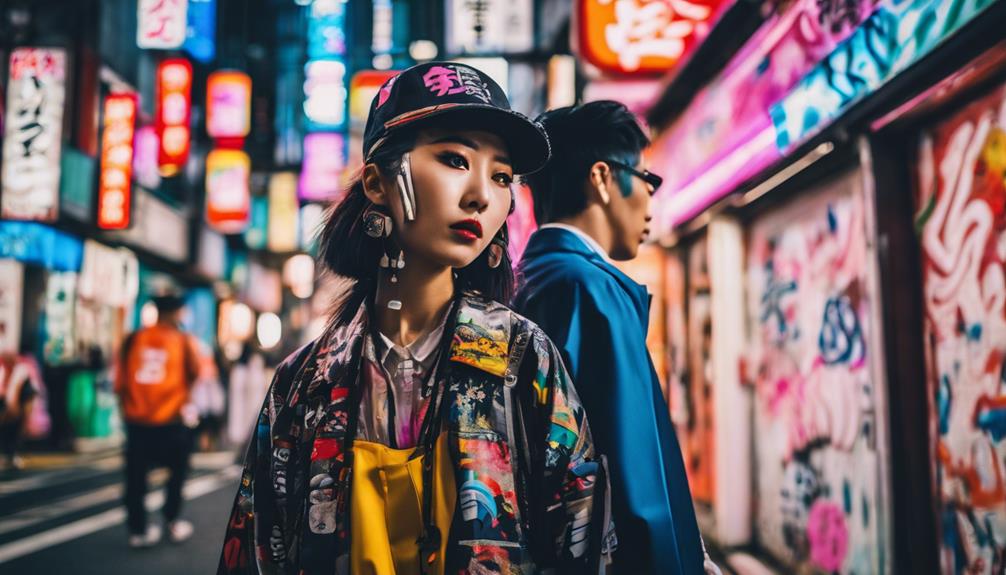
Japanese street fashion isn't just about clothes; it reflects the deep influences of anime and manga, shaping how you express yourself.
You'll see how youth activism intertwines with fashion, making statements that resonate on a global scale.
This dynamic blend showcases the cultural impact that street style has beyond mere aesthetics.
Anime and Manga Influences
Anime and manga have profoundly shaped street fashion, inspiring fans to adopt bold styles that mirror their favorite characters' unique aesthetics. You'll often see vibrant outfits influenced by iconic shows, especially within subcultures like Gyaru and Lolita. Characters from popular anime, such as *Sailor Moon* and *Attack on Titan*, serve as fashion muses, prompting you to replicate their distinctive looks in your everyday wear. This blend of fantasy and reality allows you to express your personality and creativity.
Cosplay plays a significant role in this phenomenon, as dressing up as beloved characters has become a celebrated aspect of Japanese street fashion. Enthusiasts keenly participate in events and conventions, showcasing their creativity and passion.
The rise of social media platforms like Instagram and TikTok has also amplified the visibility of anime and manga influences in street fashion. Now, you can share your outfits with a global audience, connecting with fellow fans and spreading the joy of these unique styles.
This cultural exchange continues to expand, making anime and manga an integral part of contemporary fashion. So, embrace these influences and let your style reflect your love for your favorite characters!
Youth Activism and Fashion
Street fashion has evolved into a powerful medium for youth activism, enabling you to showcase your social and political beliefs through distinctive styles that resonate with your identity and cultural background. Japanese street fashion serves as a canvas for you and your peers to express individuality and challenge societal norms. Trends like Jirai makeup highlight how fashion styles can act as a form of protest, pushing back against conventional expectations.
Events such as Tokyo Fashion Week further amplify this movement by providing a platform for emerging designers who weave activism into their collections. They tackle significant issues like sustainability and gender inclusivity, empowering you to engage with critical discussions while sporting your unique looks. The blend of traditional and contemporary fashion styles symbolizes a resistance to globalization, allowing you to reclaim and reinterpret your heritage.
Social media plays an essential role in this activism, with hashtags like #TokyoStreetFashion sparking dialogues about identity and representation. Through your fashion choices, you're not just expressing yourself; you're participating in a broader social movement that champions change and celebrates diversity. Embrace the power of fashion to make a statement and inspire others!
Frequently Asked Questions
What Is Japanese Streetwear Style Called?
Japanese streetwear style is often referred to as 'Harajuku Fashion.' It encompasses various subcultures, each with its unique aesthetics, blending traditional elements with contemporary styles that reflect the vibrant youth culture of Japan.
What Is the Most Popular Fashion Trend in Japan?
The most popular fashion trend in Japan right now is layering. You'll notice vibrant colors, bold patterns, and vintage pieces blending together to create unique, expressive outfits that showcase your personal style and creativity.
What Style of Clothing Is Japan Known For?
Japan's known for its eclectic fashion styles, from the whimsical Lolita and nostalgic Fairy Kei to the bold Gyaru and expressive Visual Kei. Each style reflects unique cultural influences, allowing you to explore diverse aesthetics.
What Is the Fashion Trend in Japan in 2024?
In 2024, you'll see layering as a standout trend in Japan, with bright colors and bold patterns capturing attention. Vintage aesthetics and unique accessories enhance outfits, embracing inclusivity through genderless fashion that celebrates personal expression.
What is the Influence of Decora Fashion on Japanese Street Fashion Trends?
Decora fashion has a significant influence on Japanese street fashion trends, with its vibrant and fun Japanese styles taking center stage. The bold colors, playful accessories, and layering techniques of Decora fashion have inspired a new wave of creativity and individuality in Japanese street fashion.
Are the Bold and Trendsetting Styles in Tokyo Also Considered Japanese Street Fashion?
Yes, the bold and trendsetting styles in Tokyo are definitely considered Japanese street fashion. The japanese fashion trends from tokyo are known for their unique and avant-garde designs, combining traditional elements with modern influences. From Harajuku to Shibuya, Tokyo is a hub for innovative and cutting-edge fashion.
Conclusion
In summary, Japanese street fashion is a vibrant expression of individuality and creativity that transcends boundaries.
By exploring its origins and understanding its key characteristics, you can confidently embrace these bold styles.
Don't hesitate to experiment with modern interpretations and unique styling tips to make the looks your own.
With the right shopping guide and upcycling techniques, you can contribute to this dynamic culture while making a statement.
Immerse yourself in this trend and let your fashion journey begin!
